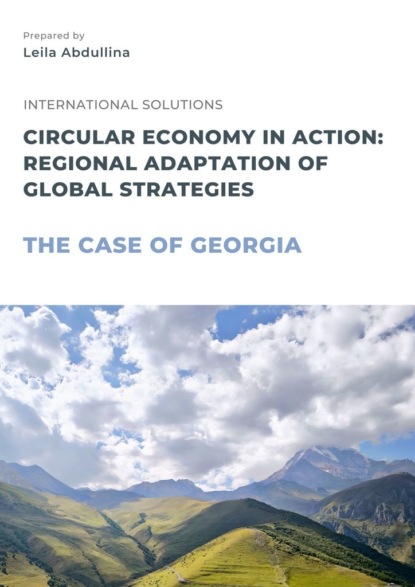
Полная версия:
Circular economy in action: Regional adaptation of global strategies. The case of Georgia
Most of the country’s territory is occupied by industrial and agricultural zones and densely populated urban agglomerations that produce huge volumes of waste and pollutant emissions. The rate of waste recycling is the most important indicator of environmental sustainability for a country. According to data [21] presented in the EPI, the 2024 recycling rate for the USA is 44 while Switzerland attained the highest EPI score of 100.The EPI metric for recycling reflects the percentage of waste processed and reintegrated into production cycles. It illustrates how efficiently a country manages its resources and incorporates circular principles into its economy. In 2022, the recycling rate in the USA was recorded at 14,8, while South Korea achieved the highest score of 67,1.
The 2024 fiscal year report from the USA EPA highlights substantial financial allocations aimed at advancing the CE and promoting sustainable resource management [22]. For instance, the total budget for the “Clean Water” program (State Revolving Fund, SRF) amounted to $6,4 billion. This funding includes both regular appropriations and allocations provided under the Infrastructure Investment and Jobs Act. The program focuses on modernizing water supply systems and wastewater treatment facilities, which reduces environmental strain and expands access to clean water for the population. A significant portion of these funds is distributed as revolving loans, enabling states to finance new projects aimed at improving water infrastructure.
Approximately $1,4 billion was allocated to research activities assessing risks to human health and ecosystems. These funds support the development of regulatory standards, such as those for drinking water quality and the protection of vulnerable communities. This research facilitates the integration of CE principles into environmental policy, minimizing negative impacts on the environment and human health.
Research institutions like the Massachusetts Institute of Technology (MIT) are the most crucial to the development of CE in the USA. In 2023, MIT initiated a research program that focused on the development of new materials and technologies that would accelerate the process of adopting CE practices. Such scientific activities are creating a fertile ground for corporate and governmental initiatives and raising public awareness about the urgent need for sustainable development.
Superfund programs, aimed at restoring contaminated sites and facilitating their reclamation, received approximately $1,6 billion in funding. These resources are allocated to land decontamination, improving land quality, and preparing sites for reuse, aligning with key principles of the CE. Such investments enhance the availability of previously polluted sites for public and commercial purposes, reducing the need to develop new land areas.
Overall, these measures reflect a strong commitment to advancing the CE by supporting infrastructure projects, fostering scientific research, and rehabilitating environmentally vulnerable areas. The funding also underscores the integration of sustainability principles into federal resource management policies.
To date, California remains one of the leaders in sustainable development and the implementation of CE principles in the USA [23]. For instance, in 2022, the state passed Senate Bill 54 (SB 54), which mandates that all packaging within California must be recyclable or compostable by 2032 (fig.6).
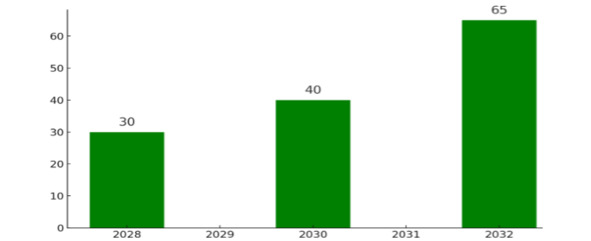
Figure 6. Plan to increase the recycling rate of plastic packaging in California, %
The premise for adopting the law was a global study conducted in 2018 [24], which found that only 9% of plastic is actually recycled, while 91% remains waste on land and in oceans.
Various American companies have implemented the working principles of the CE, promoting efficient resource use and the minimization of environmental impact. Google, among other companies, has embraced this concept and implemented measures related to the minimization of waste, utilization of recycled materials, and enhancement of energy efficiency. In 2023, the company reached the following significant marks in its work related to environmental protection. Starting this year, all new products contained a minimum of 99% post-consumer recycled plastic in product packaging, which is an uptick from 96% in 2022 [25]. The company made 34% of materials used in its products, again from recycled sources, lower than 41% made during the last year due to a change in the product lineup.
One of the important goals for Google is “Zero Waste to Landfill”. In 2023, the company could implement this goal on 29% of its data center campuses, translating to 8 out of 28 global facilities. This represents significant efforts made by Google in terms of handling better waste management and reducing pressure on the environment.
Equally important, Google is also heavily investing in renewable energy (RE). In 2023, 64% of the company’s consumption of energy was from clean sources. Besides this, Google inked contracts for an additional 4 GW of RE capacity-a record in its green energy developments. These feats put into light how Google embeds sustainability principles in all of its operations and products to reduce its environmental footprint.
Another example of successfully implementing CE principles in the USA is the work of Procter & Gamble Co. (P&G). The company actively focuses on reducing environmental impact by optimizing packaging and minimizing the use of virgin resources. As part of its strategy, P&G bases its decisions on scientific data and comprehensive life cycle analyses of materials, enabling it to minimize the environmental footprint of its products. One of P&G’s primary goals is to ensure that 100% of its consumer packaging is either recyclable or reusable by 2030, with the company having already achieved a 78% recyclability rate by the end of 2023 [26]. Additionally, P&G aims to cut its use of virgin petroleum-based plastic in packaging by 50% by 2030, with a 13% reduction already achieved by 2023.
The company is also a strong supporter of Extended Producer Responsibility (EPR) systems, which accelerate the transition to a CE and enhance waste recycling processes. Since 2020, P&G has consistently met its target of sending zero manufacturing waste to landfills (fig.7).
The company also participates in global initiatives, such as support for the UN treaty aimed at combating plastic pollution, as a manifestation of its commitment to global environmental objectives. These actions by P&G contribute to creating a closed-loop system of resource use, reducing environmental impact, and promoting the principles of sustainable development.
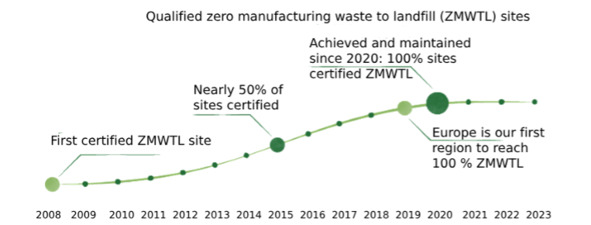
Figure 7. Qualified manufacturing waste to landfill (ZMWTL) sites
On the whole, in the USA, important steps have been taken regarding the promotion of the CE principles, mainly on the level of individual states and major corporations. However, such a model faces a number of challenges. First of all, there is an urgent need to modernize the recycling infrastructure, which still does not cover many parts of the country, especially rural and remote areas. Second, the absence of harmonized federal standards makes it very complicated to implement CE policies throughout the whole country. Third, the high-value segment of USA market products, such as packaging materials and electronics, needs advanced technologies for recycling, which can hardly allow the closed material loops to be established.
While these challenges are still at play, the outlook for the CE development in the USA remains promising. In 2023, the EPA reported that the recycling industry already supports over 680,000 jobs and contributes approximately $37,8 billion to the economy. This emphasizes the fact that the CE provides not only environmental but also major economic benefits. If current trends continue, the USA is well positioned to become one of the global leaders in CE practices that would let it meet the challenges of environmental and economic sustainability in the long term.
However, it is worth noting that a landmark event for the global community is the renewed decision of the USA to withdraw from the Paris Agreement on climate change, once again highlighting the instability of international environmental commitments by major powers. This has happened before: in 2017, the administration of Donald Trump notified the UN of its intention to leave the agreement, and the USA formally exited in 2020. However, in 2021, President Joe Biden rejoined the accord, reinstating the country’s commitment to reducing emissions. Now, in 2025, the USA has once again announced its intention to withdraw, notifying the UN that the exit will take effect in 2026. This move has raised serious concerns among world leaders and climate organizations, as it undermines collective efforts to combat global warming, weakens international climate policy, and sets a precedent for other countries, potentially making it more difficult to achieve the goal of limiting temperature rise to 1,5°C.
1.2. Developed countries of the EU
The development of the CE in EU countries depends on a combination of environmental, economic, and social factors. In the first place, transition to the CE is urged by the necessity of minimizing the negative impact of the linear economy on the environment. Among the challenges included are the depletion of natural resources, the volumes of increasing waste and greenhouse gas emissions, and degradation of ecosystems.
From an economic perspective, the CE reduces dependency on raw material imports, which is particularly critical for the EU because most of its resources are imported. In 2023, the European Commission adopted the Critical Raw Materials Act, intended to ensure the EU’s green and digital transition gets sustainable access to those resources [27]. It also points out that 90% of rare earth metals and 60% of lithium are processed in China, underlining the substantial dependence of Europe on that country’s imports. Recycling and reusing waste would reduce these risks but also enhance the strategic autonomy of Europe.
From a social point of view, the CE is perceived as a means to generate employment. The European Commission assumes that the adoption of circular models could create up to 700 000 new jobs in the EU by 2030 and increase GDP by 0,5% EU. Another significant driver for the CE is stricter legislation and strategic planning at the EU level. One of the most pivotal documents in this field is the CE Action Plan, introduced by the European Commission in March 2020 [28]. This plan, part of the European Green Deal, aims to accelerate the transition to a sustainable economic model, reduce waste, and improve resource efficiency.
The plan has a range of measures to encourage closed economic loops: in particular, increasing the recyclability and reuse of products, as well as reducing the use of raw materials. Its cardinal goals include designing sustainable products made with longer life spans, repairable, and easily recyclable or reusable. The European Commission proposed mandatory product design requirements to ensure a lower environmental footprint throughout a product’s lifecycle.
Key priorities in the action plan include the textile industry, construction, electronics, and packaging-all those which traditionally generate much waste and consume large volumes of resources. For example, the textile sector will have to implement a new sustainable textile strategy that reduces pollution and increases the use of recycled materials in products.
The reduction of plastic waste is one of the most salient features of the plan. This includes limiting single-use plastics, developing infrastructure to process complex plastic materials, and setting clear recycling targets for packaging. The document sets intermediate targets across various sectors to ensure a gradual transition to sustainable models.
Moreover, the plan provides financial support for CE initiatives through EU funding programs such as Horizon Europe and Invest EU [29]. These programs stimulate innovation and technological development in recycling and material reuse, reducing environmental pressures and enhancing the competitiveness of the European economy by decreasing its dependence on imported resources.
Thus, the 2020 CE Action Plan has become a critical tool for shaping the legal and economic framework that encourages EU countries and companies to adopt sustainable development principles. It plays a vital role in achieving the European Green Deal’s objectives, which aim for Europe to achieve climate neutrality by 2050.
As of 2023, the EU has shown significant progress in transitioning to a CE. According to Eurostat, the share of recycled materials in the EU economy was approximately 11,8%. In 2023, the circular material use rate was highest in the Netherlands (30,6%), followed by Italy (20,8%) and Malta (19,8%). The lowest rates were recorded in Romania (1,3%), Ireland (2,3%), and Finland (2,4%). Detailed data is presented in fig. 8.
When assessing material types, the circularity rate at the EU level was highest for metal ores at 24,7% (+2,2 percentage points compared to 2022), followed by non-metallic minerals at 13,6% (+0,3 percentage points), biomass at 10,1% (+0,7 percentage points), and fossil energy materials/carriers at 3,4% (+0,6 percentage points).
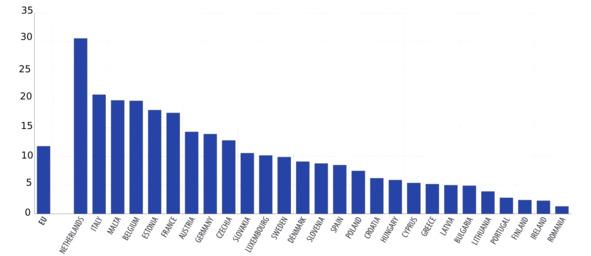
Figure 8. Circular material use rate in the EU, 2023, % [30]
The CE impacts a wide range of industries. In manufacturing, active development is taking place in the recycling programs of rare earth metals and other critical resources, which reduces dependence on imports. Another target has been the construction industry: construction waste is being recycled, and the use of secondary concrete and steel reduces the carbon footprint [31]. The textile industry has been implementing take-back and recycling programs for clothes, shifting to the use of recycled materials. Biofertilizers made from organic waste are also being introduced into agriculture, reducing the use of chemical fertilizers. The transport sector is actively developing battery recycling for electric vehicles, while energy produces recyclable components of solar panels and wind turbines. The packaging industry is focused on introducing reusable solutions, systems for collecting plastic, paper, and glass.
Accelerators that will help speed up the transition to a CE in the EU include different legislative initiatives, investments, and political programs. Among them, the well-known legal accelerator is the CE Action Plan presented by the European Commission in 2020.
Among the investments, Horizon Europe has to be highlighted; the program allocates considerable financial means to research and development of the CE, including recycling, batteries, building materials, and textiles. The estimated budget of this program for financing from 2021 to 2027 is €93,5 billion.
However, despite these accelerators, there are several barriers that slow down the transition to a CE [32]. Among the legal barriers, complex bureaucratic procedures related to waste recycling stand out. For example, differences in legislation between EU member states create obstacles for cross-border cooperation in waste management. Some countries face insufficient coordination between authorities, making it difficult to implement unified standards.
The infrastructure issues remain one of the big barriers: In numerous EU countries-especially Southern and Eastern Europe-the recycling infrastructure for such waste remains underdeveloped. Due to the limited amount of recycling plants and lack of modern landfills, an imbalance between different regions will hamper CE ambitions.
Transitioning to a CE generates major economic benefits in the EU. This transition impacts some of the main economic aspects: reducing the dependency on imported resources, creating new job opportunities, stimulating innovation, and reducing the waste and environmental pollution costs. All of these factors impact positively the economy of the region long-term and set up a sustainable basis for growth (table 1).
Table 1. Economic benefits and long-term impact of the transition to a CE in the EU
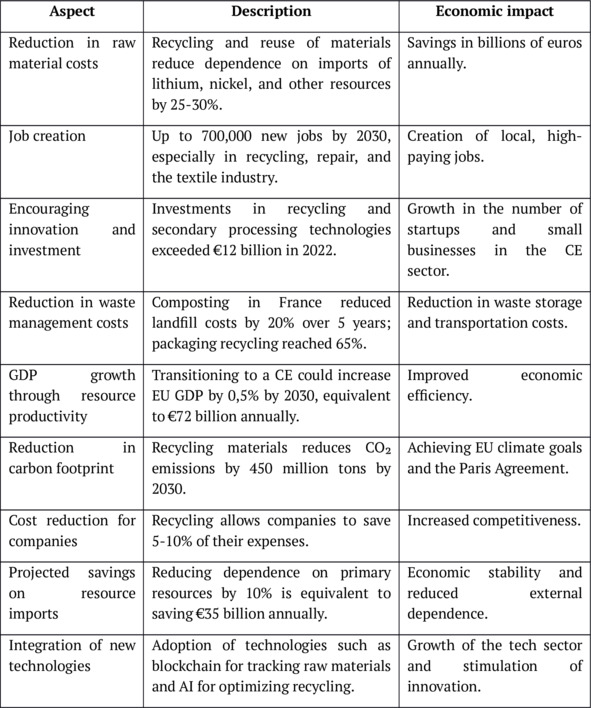
Technological bottlenecks are linked to the insufficient maturity of the recycling technologies of specific materials such as composite plastics, lithium-ion batteries, and textile fibers. The other challenge is related to a lack of awareness and low consumer engagement. Insufficient information on the importance of recycling and reusing materials among some EU citizens reduces the effectiveness of CE programs at the level of a household.
1.2.1. Estonia
Estonia is one of the most progressive countries in Northern Europe regarding sustainable development and environmental care. Due to its advanced digital infrastructure, high level of citizen engagement in environmental issues, and innovations that are being actively supported, Estonia has succeeded in building a green economy. In the last years, the country is also actively developing a CE, what is reflected in its legislative and economic initiatives. In 2024, Estonia received the highest rating in the EPI and confirmed its leadership in environmental governance (table 2).
Table 2. EPI Index [21]
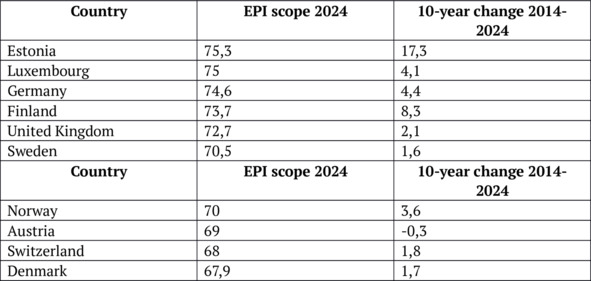
Among the initial steps in transitioning to the CE was the adoption in 2014 of the Estonian Sustainable Development Strategy, which provided goals for switching from the linear to the circular economic model. In 2017, the CE Action Plan was approved, stipulating goals for the recycling and reuse of materials [33]. One of the biggest undertakings was the incorporation of necessary recycling levels for plastics and other materials within the law, adding tax credits for companies already seriously investing in sustainable production methods.
Laws and legislative developments form a very important part in promoting the CE. First of all, the so-called Waste Recycling Act has regulated the process of separation and further processing of garbage [34]. In 2019, Estonia also adopted the CE Act, which requires companies to use recycled materials and develop products with consideration for their future recyclability or reuse. These laws support the mandatory recycling of plastics, paper, glass, and other materials, while also encouraging the adoption of green technologies.
Over the years, the Estonian waste collection industry has recorded a gradual annual turnover increase that is proportional to the rise in concern for environmental sustainability and material recycling [35]. Due to infrastructure development for recycling purposes and waste processing technologies, the performance has been promising for years (fig.9).
However, the greatest challenge Estonia faces at present is meeting the set target by the EU in regard to waste recycling. Currently, the country is significantly behind the level of household waste recycling required and may face relevant penalties by the EU. By 2025, Estonia is bound to recycle at least 55% of household waste, but the current rate of recycling stands at only 33% of greenhouse gas emissions and promote the closed-loop cycle of energy production. It has a strategic plan for changing to 100% RE by 2030.

Figure 9. Annual turnover of the waste collection industry in Estonia from 2013 to 2022, million euros [36]
In the field of energy, Estonia emphasizes the development of RE sources. In 2022, more than 40% of the produced electricity came from renewable sources, including biomass and wind power plants. Waste-to-energy technologies, such as biogas plants that convert organic waste into biogas, are in active use. Such technologies contribute to the reduction.
This has a counterpart among the industrial companies in Estonia, with a bright example being Enefit Green, active in industrial waste usage for biomass and RE production. In 2023, the company was recycling organic waste in remarkable volumes that contributed to considerably lowering the environmental footprint of its production and improving circularity metrics.
Meanwhile, Estonian companies and startups also have contributions in regard to CE solutions. As one example, Polymer Deka has focused on the recycling of plastic waste; a developed technology allows converting plastic waste into new construction materials that make production with a low carbon footprint. EcoTree is another such startup processing wood waste to make environmentally friendly construction materials.
Education and public awareness help further the CE within Estonia. In 2021, the National Environmental Education Plan was adopted, also including programs of citizens’ and entrepreneurs’ education on principles of sustainable consumption and waste management. The initiatives also include waste separation campaigns, as well as educational programs for raising the level of awareness about the CE principles.
Thus, Estonia illustrates successful integration of the CE at all levels, from government policies to corporate initiatives. Implementation of environmental innovations, increase in recycling rates, and sustainable consumption, together with active engagement of citizens, enables the country not only to hold high positions in environmental sustainability rankings but also to contribute substantially to the global struggle against climate change. However, meeting the overall sustainable development targets set by the EU remains an ongoing task.
1.2.2. Switzerland
Switzerland is one of the world leaders in the field of CE, showing very high indexes of waste recycling, use of resources in a friendly to environment way, and implementation of newest technologies [37]. This is a small but highly developed country that actively applies the comprehensive approach based on strict legislation, state support, and ecological consciousness of the population. The EPI reached 100 in 2024 for the waste recycling rate, which means that Switzerland’s waste management system is truly effective and corresponds to the highest international standards.
Switzerland started creating the very foundation of its CE back in the 1980s when the first laws aimed at waste minimization and recycling were introduced. A key step was the adoption of the 1983 Environmental Protection Act, which set strict standards for the handling of household, industrial, and hazardous waste. In 2001, the Waste Disposal Act came into effect, effectively banning the burial of unsorted waste. All waste must be either recycled or sent for energy recovery. These legislative measures, based on modern technologies, presupposed the recycling of domestic waste and the reprocessing of the rest by heat, which practically excluded the use of landfills.
Switzerland possesses probably the most effective system of separating garbage in the world. In the country, citizens are obliged to sort garbage, separating paper, glass, plastic, metals, and organic waste, which are then sent to recycling [38]. The glass recycling rate reaches 95%, the plastic packaging is recycled at a rate of 82%, and the recycling rate for aluminum and steel is over 90%. Organic waste makes up a large part of recyclable waste, and half of it is utilized in the production of biogas and compost, which diminishes greenhouse gas emissions and encourages local agriculture.
The high rate of success in Switzerland is also based on active public involvement. Education in Switzerland starts at the elementary school level, where principles of waste separation and sustainable consumption are taught to children. The active adult population supports all environmental initiatives, taking an active part in recycling programs and choosing products in an environmentally friendly way. Such a culture contributes not only to a high rate of recycling but also to the development of the market of recycled materials.



